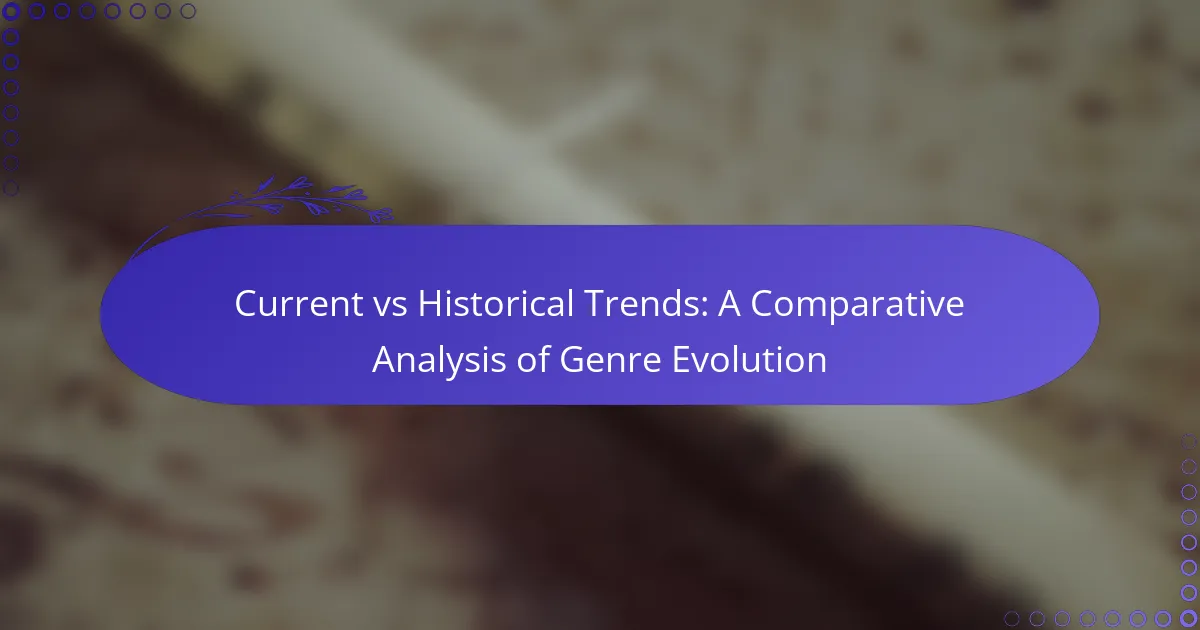The evolution of music genres is a dynamic interplay between current trends and historical influences, each shaping the soundscape in unique ways. Today, technological advancements and the rise of digital platforms have catalyzed the emergence of new styles and hybrid genres, making music more accessible than ever. By examining historical trends, we can gain valuable insights into the cultural and social factors that have driven these transformations over time.
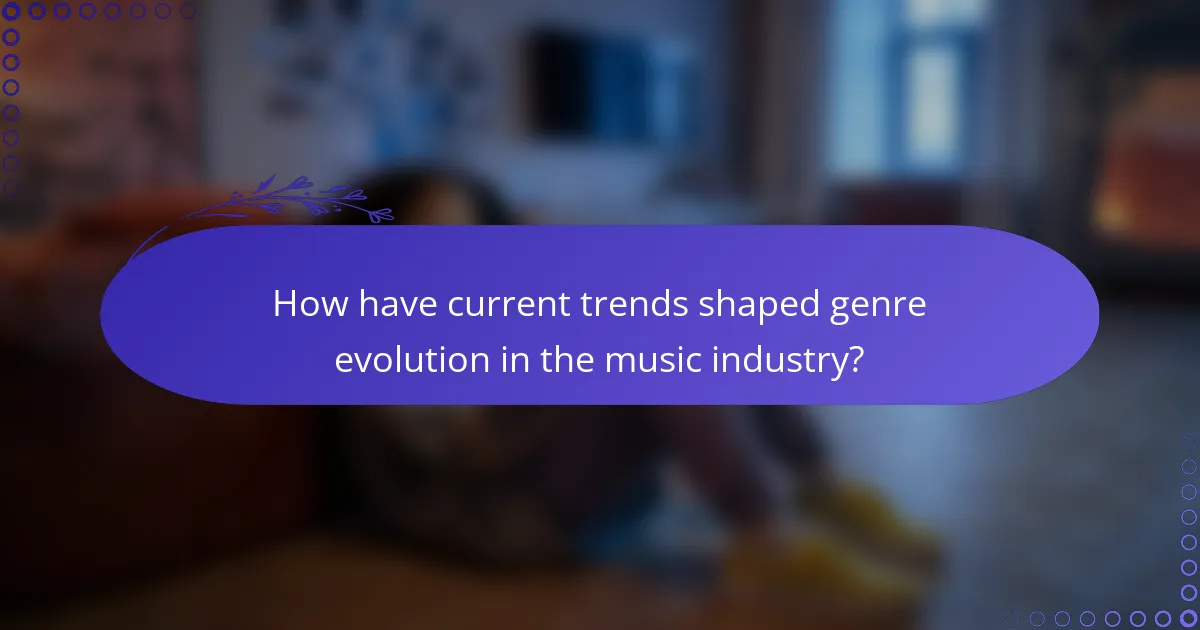
How have current trends shaped genre evolution in the music industry?
Current trends have significantly influenced genre evolution in the music industry by fostering new styles and hybrid genres. The rise of technology, particularly streaming platforms and social media, has transformed how artists create and distribute music, leading to a more diverse and accessible sound landscape.
Influence of streaming platforms
Streaming platforms like Spotify and Apple Music have reshaped genre evolution by allowing artists to reach global audiences instantly. These platforms utilize algorithms that promote a wide variety of genres, encouraging listeners to explore beyond their usual preferences.
Moreover, the data collected from user listening habits enables artists and producers to identify emerging trends and adapt their music accordingly. This responsiveness can lead to the rapid emergence of new sub-genres, as artists experiment with sounds that resonate with listeners.
Rise of genre-blending
Genre-blending has become increasingly prevalent, with artists merging elements from different styles to create unique sounds. This trend reflects a shift away from rigid genre classifications, allowing for more creative freedom and innovation in music production.
For example, collaborations between hip-hop and country artists have gained popularity, showcasing how diverse influences can attract broader audiences. This blending not only enriches the music but also challenges traditional genre boundaries.
Impact of social media on music discovery
Social media platforms like TikTok and Instagram have revolutionized music discovery, enabling songs to go viral and reach millions within days. These platforms allow users to share snippets of songs, often leading to increased interest and streaming numbers for emerging artists.
Additionally, social media fosters direct interaction between artists and fans, creating communities around specific genres or styles. This engagement can help new genres gain traction quickly, as fans share their discoveries and promote their favorite tracks across their networks.
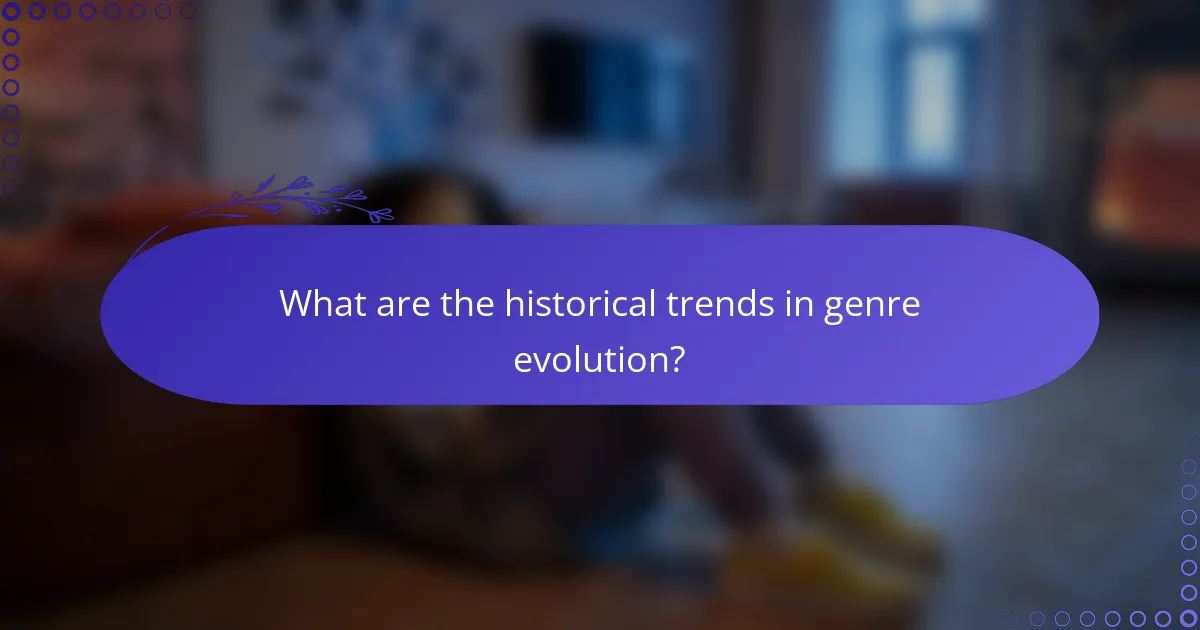
What are the historical trends in genre evolution?
Historical trends in genre evolution highlight how music styles have transformed over time, influenced by cultural, technological, and social changes. Understanding these trends provides insight into the origins and development of various genres, shaping the music landscape we know today.
Origins of major music genres
The origins of major music genres can often be traced back to specific cultural movements and geographical regions. For example, jazz emerged in the early 20th century in New Orleans, blending African rhythms with European musical traditions. Similarly, rock and roll originated in the United States during the 1950s, drawing from blues, country, and rhythm and blues.
Genres like hip-hop began in the 1970s in the Bronx, New York, as a form of expression for marginalized communities, combining spoken word with rhythmic beats. Each genre’s roots reflect the societal influences and technological advancements of their time, creating a rich tapestry of musical history.
Key historical milestones in genre development
Key historical milestones mark significant shifts in music genres, often driven by technological innovations or cultural phenomena. The introduction of electric instruments in the 1930s and 1940s transformed genres like blues and jazz, leading to the birth of rock music. The 1980s saw the rise of electronic music, with synthesizers changing the soundscape of pop and dance music.
Another pivotal moment was the advent of the internet in the late 1990s, which revolutionized how music is distributed and consumed, leading to the emergence of genres like indie pop and lo-fi. Understanding these milestones helps to contextualize the ongoing evolution of music genres and their relevance in contemporary culture.

How do current trends compare to historical trends?
Current trends in genre evolution often reflect significant shifts from historical patterns, driven by changes in technology, audience preferences, and cultural influences. While historical genres established foundational norms, today’s genres are more fluid and diverse, adapting rapidly to societal changes.
Shifts in audience demographics
The demographics of audiences have shifted dramatically over the years, influencing genre popularity and development. Historically, genres often catered to specific age groups or social classes, but now they appeal to a broader, more diverse audience. For example, streaming platforms have enabled genres like anime and indie films to gain traction among younger viewers globally, transcending traditional boundaries.
Understanding these demographic shifts is crucial for creators and marketers. Engaging with diverse audiences requires recognizing varying tastes and preferences, which can differ significantly across regions. For instance, genres that thrive in North America may not resonate the same way in Europe or Asia, necessitating localized content strategies.
Changes in production techniques
Production techniques have evolved significantly, impacting how genres are created and consumed. Advances in technology, such as high-definition video and sophisticated CGI, have transformed visual storytelling, allowing for more ambitious projects that were previously unfeasible. For example, the rise of virtual reality (VR) and augmented reality (AR) is creating new genre experiences that blend traditional storytelling with interactive elements.
Moreover, the democratization of production tools has enabled independent creators to produce high-quality content on lower budgets. This shift has led to a surge in niche genres, as creators can explore unique themes and styles without the constraints of traditional studio systems. Embracing these new techniques can enhance creativity and broaden genre definitions, appealing to modern audiences.
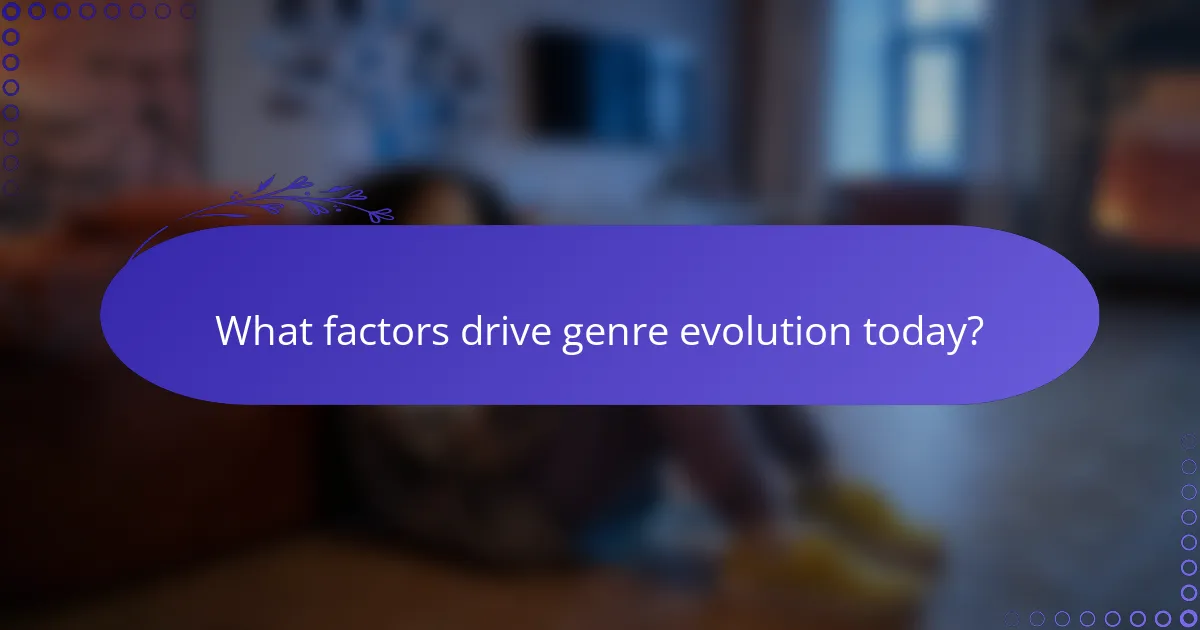
What factors drive genre evolution today?
Genre evolution today is primarily driven by technological advancements and the globalization of music. These factors influence how artists create, distribute, and promote their work, leading to new sounds and styles that reflect contemporary culture.
Technological advancements
Technological advancements play a crucial role in genre evolution by enabling new methods of music production and distribution. Digital audio workstations (DAWs), synthesizers, and software plugins allow artists to experiment with sounds that were previously difficult or impossible to achieve.
Moreover, streaming platforms have transformed how music is consumed, making it easier for listeners to access a diverse range of genres. This accessibility encourages cross-genre collaborations and the blending of styles, resulting in innovative musical forms.
Globalization of music
The globalization of music has significantly impacted genre evolution by facilitating cultural exchange. Artists from different countries can now share their influences and collaborate across borders, leading to the emergence of hybrid genres that incorporate elements from various musical traditions.
For example, the fusion of traditional African rhythms with Western pop has given rise to genres like Afrobeats, which have gained international popularity. This blending not only enriches the music landscape but also reflects the interconnectedness of today’s global society.

What are the implications of genre evolution for artists?
Genre evolution significantly impacts artists by creating new avenues for expression and collaboration while also presenting challenges in maintaining their unique identities. As genres blend and transform, artists must navigate these changes to stay relevant and true to their artistic vision.
Opportunities for cross-genre collaborations
Cross-genre collaborations allow artists to reach broader audiences and innovate their sound. For instance, a traditional folk musician might collaborate with a hip-hop artist, resulting in a fresh fusion that attracts fans from both genres. Such partnerships can lead to unique projects that might not have been possible within the confines of a single genre.
Artists can leverage platforms like social media to showcase these collaborations, enhancing visibility and engagement. By experimenting with different styles, they can also discover new creative directions, which can be beneficial for their artistic growth.
Challenges in maintaining artistic identity
As genres evolve, artists may struggle to maintain their distinct artistic identity amidst the blending of styles. The pressure to conform to popular trends can lead to a dilution of their original sound, making it essential for artists to find a balance between innovation and authenticity. For example, an artist known for their unique sound may feel compelled to adopt mainstream elements to attract a wider audience.
To navigate this challenge, artists should regularly reflect on their core values and artistic goals. Setting clear boundaries on what aspects of their style they are willing to adapt can help preserve their identity while still embracing the evolution of genres.
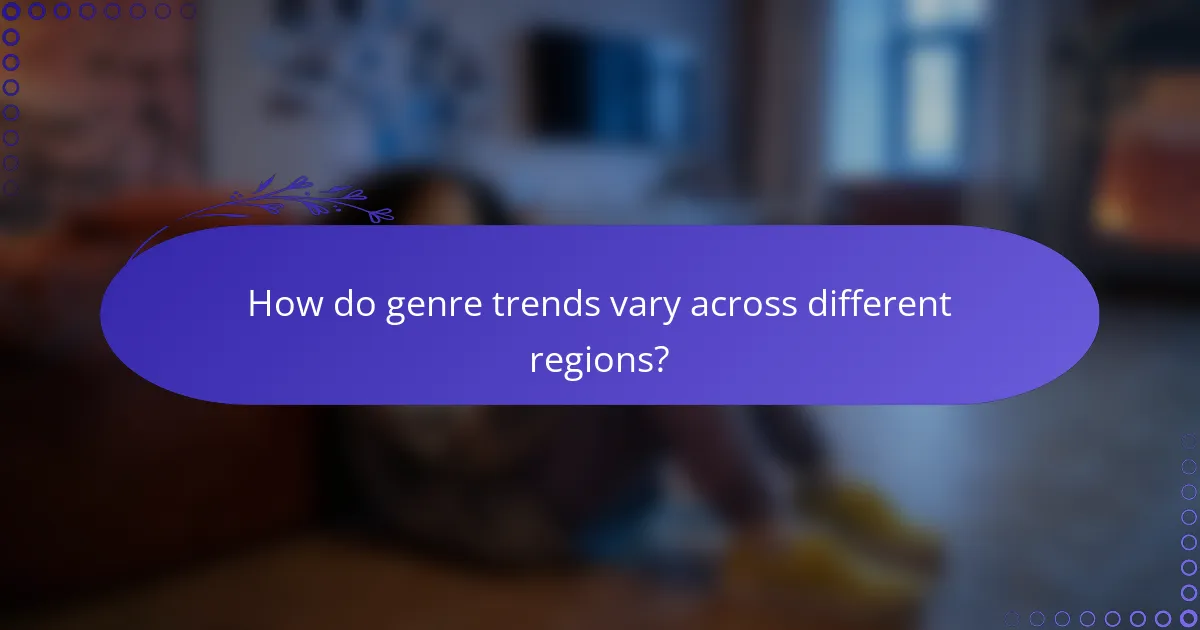
How do genre trends vary across different regions?
Genre trends can differ significantly across regions due to cultural influences, local music scenes, and historical context. Understanding these variations helps in grasping how music evolves and resonates with different audiences.
Regional music scenes in North America
North America boasts a diverse array of music genres, heavily influenced by its multicultural population. Genres like hip-hop, country, and rock have distinct regional characteristics, with cities such as Nashville known for country music and Los Angeles for pop and rock. Local artists often draw inspiration from their surroundings, leading to unique sounds that reflect regional identities.
In recent years, the rise of streaming platforms has allowed regional genres to gain wider exposure. For instance, genres like reggaeton and trap have seen increased popularity beyond their traditional bases, showcasing how North American music trends can be shaped by global influences.
Influence of European music festivals
European music festivals play a crucial role in shaping genre trends across the continent and beyond. Events like Glastonbury in the UK and Tomorrowland in Belgium not only highlight popular genres but also introduce emerging artists to international audiences. These festivals often serve as a melting pot for various musical styles, encouraging cross-genre collaborations.
Additionally, the festival culture in Europe emphasizes live performances, which can significantly impact genre popularity. Genres such as electronic dance music (EDM) and indie rock have gained traction through festival circuits, demonstrating how live events can drive trends and influence listener preferences across regions.
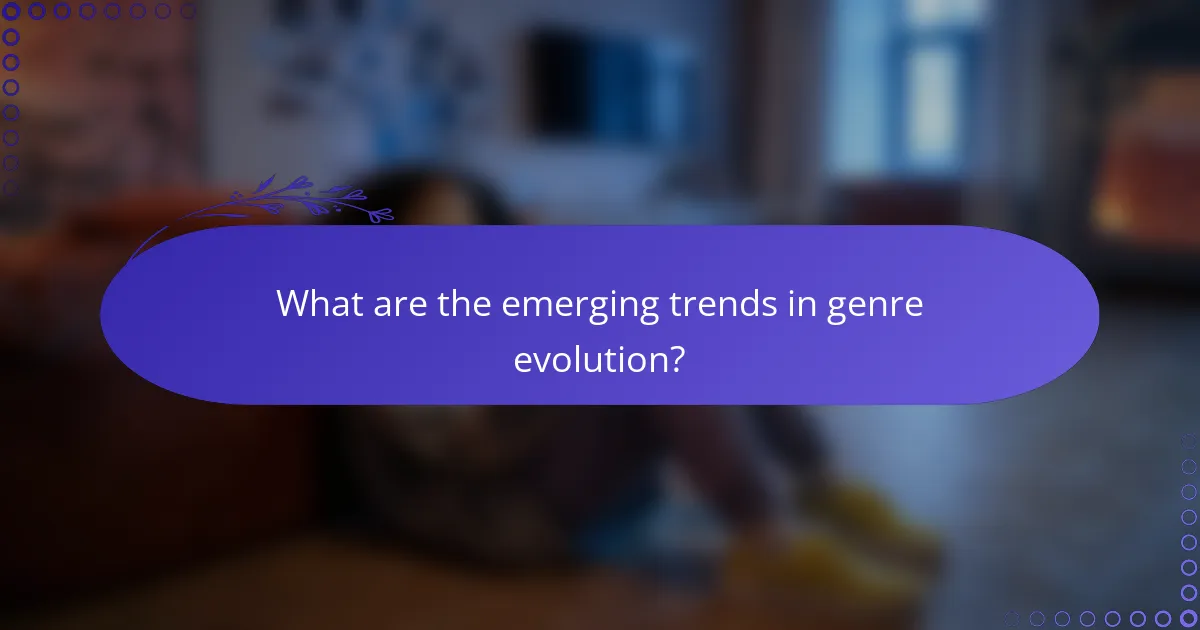
What are the emerging trends in genre evolution?
Emerging trends in genre evolution reflect the dynamic nature of music, influenced by technology, culture, and audience preferences. Genres are increasingly blending, leading to hybrid styles that challenge traditional classifications and expand creative possibilities.
Impact of artificial intelligence on music creation
Artificial intelligence (AI) is transforming music creation by enabling artists to experiment with new sounds and structures. AI tools can analyze vast amounts of data to identify patterns, helping musicians generate original compositions or enhance existing works.
For instance, AI algorithms can assist in songwriting by suggesting melodies or harmonies based on user input. This technology allows for rapid prototyping of musical ideas, making it easier for artists to explore different genres and styles without extensive training.
However, reliance on AI can lead to homogenization in music if artists do not maintain their unique voice. Musicians should balance AI assistance with personal creativity to ensure their work remains distinctive and authentic.
